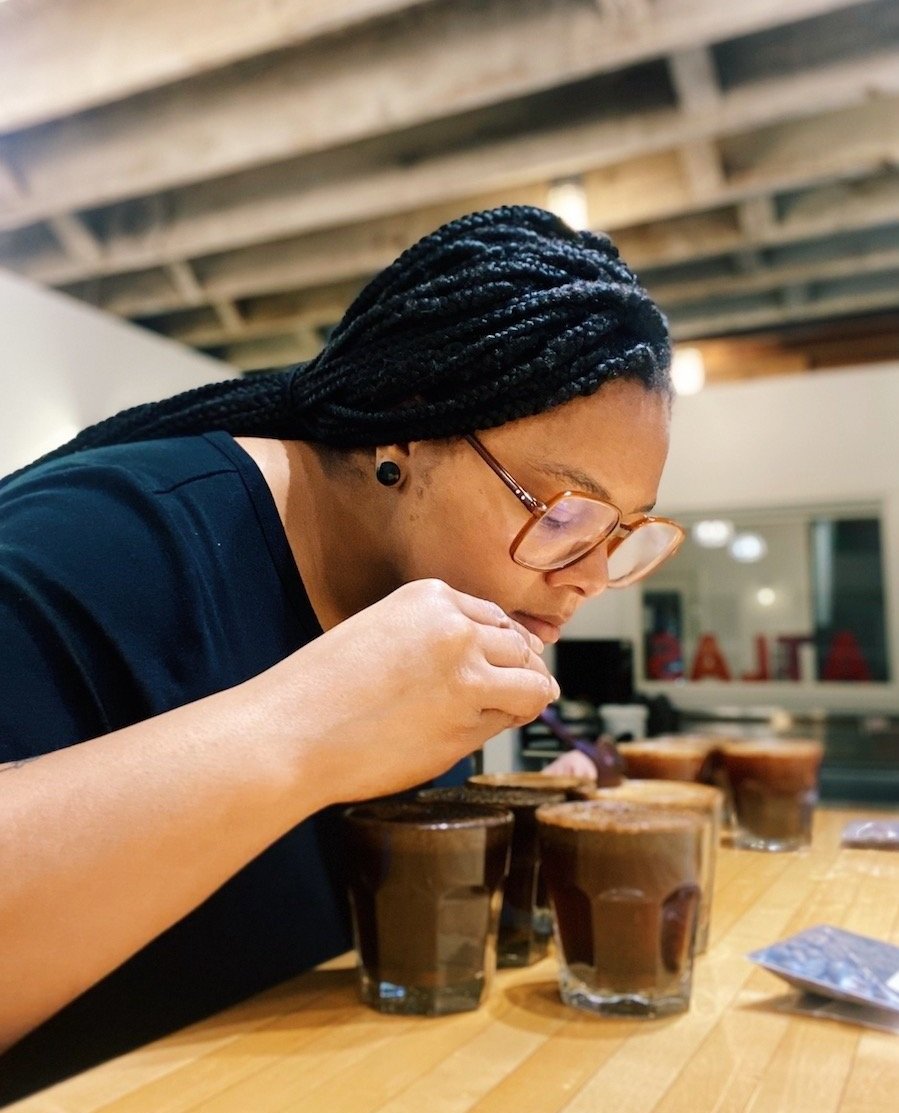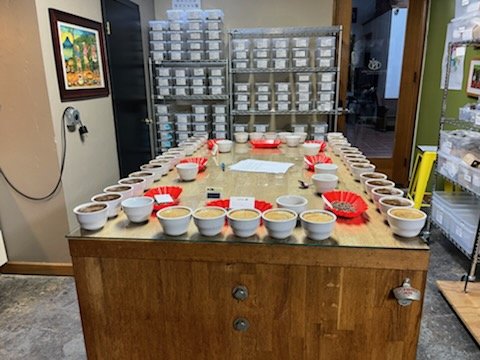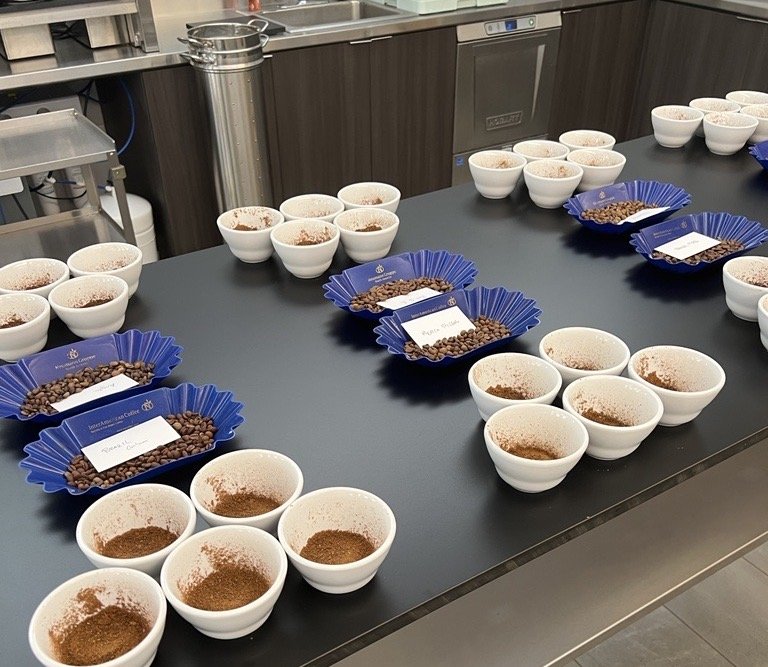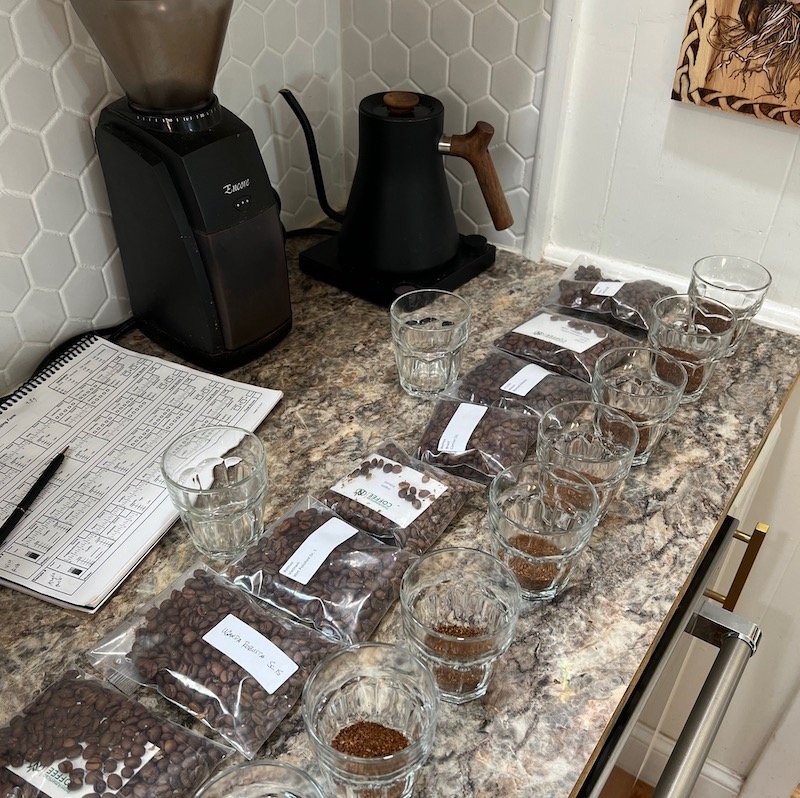How Remote Calibrations to Address a Challenge Became a Major Strength
For the remote calibrations, everyone cups individually, in their own spaces and on their own schedules, and then gathers to discuss scores and notes.Through daily cuppings with their local teams, each NKG PACE Partner has come to know the coffees and cuppers unique to their office placements across the NKG US companies. Designing the NKG PACE program, we knew that the different practices in each lab would create some asymmetries, and that — equipped with the best practices they learned during orientation week — the Partners would have to do their best to adjust. In the interest of addressing these differences, as well as to build confidence in their sensory abilities and familiarity with using the SCA cupping form, we began the joint, remote effort of bi-weekly cupping calibrations.
The responsibility of arranging the cupping rotates across the Partners. On their week, they must choose six to eight coffees – sometimes guided by an underlying theme, sometimes just out of curiosity – roast the samples, label them and ship sets out to each cupping participant. We each cup individually in our own spaces, on our own schedules, and gather the following week to discuss scores and notes.
These calibration cuppings have turned out to be a valuable part of the curriculum. They give the Partners an opportunity to cup coffees outside of the samples they’re exposed to day-to-day, and they create a space for discussion with people outside of their everyday sensory teams. It has also been a moment of community building where we can enjoy each other’s insights and even discuss how to navigate cupping dynamics particular to each office.
Porttia Portis, cupping in the Atlas Coffee Importers lab in Seattle. Big Themes, Big Learning
Given the intellectual proclivities of our NKG PACE Partners, it should come as no surprise that these cuppings have also become a bit of a venue for big-picture conversations. They provide a space to float ideas that address larger themes in our learnings and in our industry. One example is our most recent calibration, arranged by Charles Umeano, who works in the NKG US headquarters in Hoboken, NJ.
In the Hoboken lab, Charles is exposed to the widest range of coffee qualities of any of our Partners and is privy to conversations between InterAmerican and Rothfos Corporation traders and QC managers about availability, pricing and real-time adaptive strategies to meet the needs of clients. Given this context, as well as his personal interests, Charles prepared a table for us that was rooted in musings around long-term sustainability.
We were each sent a set of eight samples, including a Peru SHG G1, which is currently a difficult coffee to obtain for a myriad of reasons (lean crop, competing Colombia differentials and shipping delays, to name a few). He put this sample up against two specialty grade Brazil naturals and five well-prepared Robusta coffees from different countries (Mexico, Uganda, Angola, Vietnam, Brazil) with different preparations (washed, natural, wet polished and conilon).
“The idea is to see where/when we would advise a specialty coffee customer to consider a Robusta, particularly as they become more common place as suitable environments for growing Arabica decrease,” Charles instructed.
From left to right, Jayy Terrell prepared their cupping in the InterAmerican Coffee San Diego lab; Charles Umeano prepared his in the Neumann Gruppe USA lab in Hoboken; and QC & Education Lead Amanda Armbrust-Asselin, who works remotely, prepared her cupping at home.
The scenario Charles proposes might seem extreme to those of us working exclusively with specialty coffee, but perhaps not far down the line — in a time where climate change has truly amputated entire regions of land previously suitable for cultivating Arabica — the question of a Robusta replacement will be increasingly relevant. We are already seeing customers venture into lower-grade coffees under the pressure of increased prices and decreased availability. This scenario is perhaps already upon us.
These are the conversations being had by traders and customers. We work in the QC lab, where we are tasked with providing objective data from which traders can make such purchasing and sales decisions. But after this exercise, our wheels are turning. Charles is definitely onto something with the lineup he curated.
While we all agreed the Peru SHG G1 stood above the rest, we had some very interesting conversation about how much, and in what ways. Additionally, we all agreed that the coffees he offered up in comparison brought their own value to the table, so to speak. This creative thinking is exactly what the industry needs to cultivate in the next generation of coffee professionals. I am so excited to see where, in their next roles, the NKG PACE Partners take us. •
—
Amanda Armbrust-Asselin is the QC & Education lead for NKG PACE and Neumann Gruppe USA.




